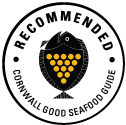

Oysters are delicious and good for you with a distinctive taste of the sea. Pacific oysters are a non-native species that has been introduced to the UK for aquaculture. It is much more commonly found offered for sale than the native or flat oyster. Pacific oysters are more irregularly shaped than their flat native cousins, and the edges of the shell have distinctive wavy, large frills.In some areas this species has escaped captivity and has become an invasive species, they are sometimes sold as 'rock oysters'. Oysters have to be depurated (sterilized) before being eaten so self collection is not advised.
There are now two main sources of Pacific oysters available to consumers. Wild caught and farmed. Pacific oysters have been commerially farmed on the banks of the Camel estuary since the 1960's. And historically Pacific oyster farming has also taken place in the Helford, Fal, Fowey and Tamar Estuaries. They are usually cultured in mesh sacks which are turned by hand at low tide. The culture of oysters is low impact and doesn’t add pollution to the water.
In the 1950's and 60's government advice was that sea temperatures were not warm enough in the UK for Pacific oysters to sucessfully reproduce. This advice is now out dated and there are numerous examples of oyster larvae (spat) escaping and colonising nearby natural habitats. In the Camel estuary this hasn't happened, possibly due to the sandy nature of the environment in this area preventing the settlement of spat. However, in Cornwall's south coast estuaries and bays Pacific oysters have now formed wild populations, and in some areas they significantly alter the nature of the shore creating sharp intertidal oyster reefs, and smothering intertidal rock.
Some fishermen already collect feral oysters but report that there is currenly not a large market for them. The oysters themselves are irregular in shape and sometimes very large (up to 30cm long), and a product sometimes sold as a 'Rock oysters'. We hope that better markets can be found for these feral (wonky) oysters to enable the oyster populations in our estuaries to be controlled by hand collection. Oysters found growing on rocky reefs on the intertidal are flatter and harder to remove without damaging them therefore they cant be sterilised. An alternative use for these needs to be found in order to control populations.

Cornwall

Hand collection of feral oysters is one method to keep wild populations of this non native species under control. The MCS methodology does not currently allow rating Non native species, however it is recommended by Cornwall Good Seafood Guide
Learn more
Cornwall
Farmed on the shore in semi rigid plastic mesh cages. Rating is provided using the MCS aquaculture ratings methodology.
Learn moreCornwall Good Seafood Guide rates seafood sustainability using a scale of 1to 5
1,2 and 3 are recommended, Fish to avoid are rated 5.
The ratings for this species are produced independently by Cornwall Wildlife Trust as a guide to help consumers make good seafood choices. click here.
Oysters belong to the commercially important group of bivalve molluscs which also includes mussels, clams and cockles. The Pacific oyster, now widely distributed, originated in northeastern Asia. Pacific oysters begin life as males, but may change sex more than once during their lifetimes. Sexes are separate, but hermaphrodites sometimes do exist. In habitats with a high food supply the sex ratio in the adult population tends to favour females, whereas in areas with low food abundances it tends to have a larger proportion of males.
Farmed oysters are bred in hatcheries and then grown on in the sea - usually in semi-rigid plastic mesh bags, supported by steel trestles secured in intertidal waters. Pacific oyster producers rely on spat from oyster hatcheries which have been manipulated (making them triploid - having three sets of dna) which ensures that they should not spawn in the wild although some escapees have been found in recent years in Cornish estuaries, where they appear to now have self sustaining populations. Research currently being carried out by Natural England, Cornwall Wildlife Trust and South Devon ANOB Estuaries Partnership, and funded by European and Marine Fisheries Fund is showing that feral populations are far greater than expected in Devon and Cornwall with numbers have exploded in recent years. Currently fishing levels on this species are minimal. Commercial collection is a potential method of controlling this species.
Marine aquaculture is regulated by DEFRA and environmental health. Although they spawn in summer farmed oysters are available all year round as after harvesting they are carefully depurated to remove impurities and toxic algae.
Farmed on the shore often on steel tressels in semi rigid plastic mesh cages.
Hand collected.
The Pacific Oyster, (Crassostrea gigas) in the UK, Economic, Legal and Environmental issues associated with its cultivation, wild establisment and exploitation; Shellfish Association of Great Britain, 2012






Cornwall Good Seafood Guide is underpinned by the Marine Conservation Society (MCS) Good Fish Guide. The first UK consumer guide to sustainable seafood. For more information visit www.fishonline.org
Cornwall Good Seafood Guide is here to help us all make sustainable seafood choices. Choices that will help us keep the oceans healthy and Cornish fishers' futures safe. This website is funded by Cornwall Wildlife Trust. If you would like to make a meaningful difference to the health of our oceans, please consider making a donation to the Cornwall Wildlife Trust Ocean Emergency fund. Your donation will help safeguard these remarkable environments, ensuring that they continue to thrive for generations to come. Together, we can be stewards of the seas and champions for a healthier, more sustainable future.